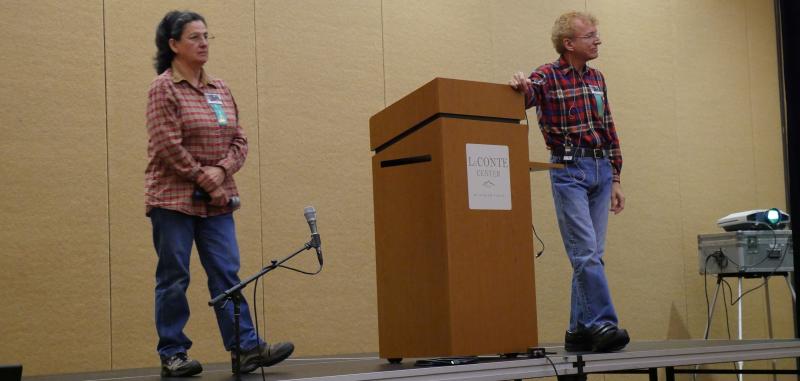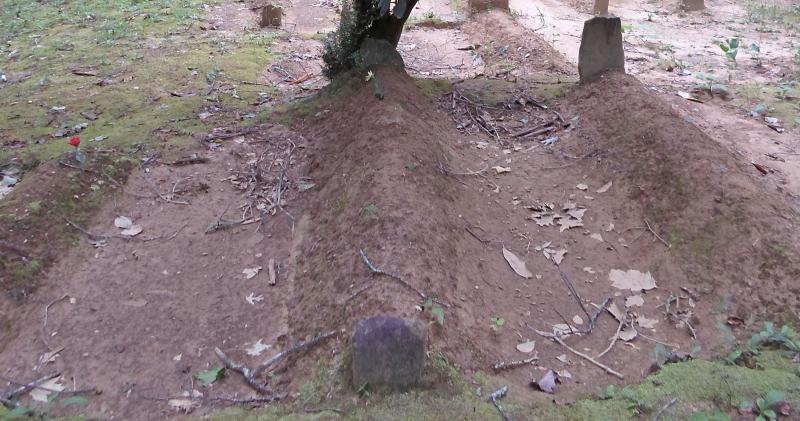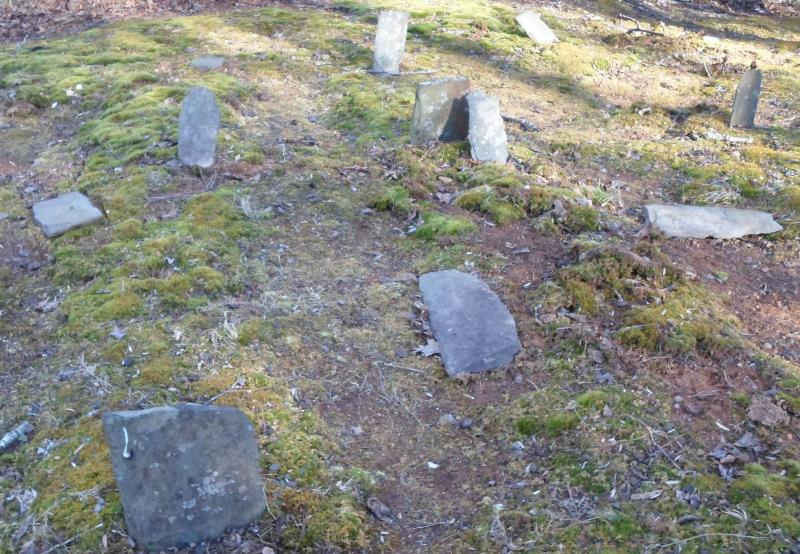Questions and Answers

(Photo courtesy Carolina Lebar)
What was the purpose of mounding a grave?
Do you practice dowsing?
Why do you post your cemetery work on the GoSmokies website instead of here on your own website?
Why are some of the cemeteries carefully maintained while others are allowed to grow up in weeds?
Why do so many of the headstones have no inscription engraved on them?
Why are there so many child and infant graves?
Where do the flowers on the graves come from?
Do you communicate with the spirits of the dead?
Do you intend to publish a book about the cemeteries?
Can I sign up to receive updates on the Remembrance Project?

What was the purpose of mounding a grave?
For those new to the concept, mounding is the practice of creating a long, narrow mound of dirt the length of a grave from the headstone to the footstone. A typical mound is less than a foot wide, narrower than the coffin it covers.
Mounding served three purposes. First, it acted as a corrective measure against the inevitable sinking of a grave as the wooden casket decays and collapses. Second, even the poorest person who could not afford a fine monument could still do something special that communicated that the grave was being actively tended. Third, since many graves were marked only with common stones, it claimed the ground so that no one else might accidentally dig there.
In cemeteries where mounding was practiced, modern-day caretakers continue the practice to honor the traditions of the original residents.

Do you practice dowsing?
For readers who might not be familiar, dowsing (sometimes spelled "dousing") is the use of divining rods to determine where bodies are buried in otherwise unmarked graves (the same technique used in "water witching").
We have experimented with the technique, but do not consider ourselves proficient. We are privileged to interact regularly with several respected cemetery historians who practice the technique, so we will not summarily dismiss its validity - however, we harbor a certain objective skepticism. We have looked at more than one formal study where noted practitioners were unable to identify known graves under controlled conditions.
We have heard of master dowsers who claim the ability to identify the gender and general age of the deceased through dowsing. Others purport to summon up even more detail. It might be one thing to state that there is a body buried here, but to further state it is an adult male with one arm missing is somewhat a stretch of credulity.
Many of these dowsings border into the territory of psychic readings, even if the practitioner attributes the results to the reactions of the metal wands. It is not so different from a police detective soliciting the input of a psychic to help solve a crime - it is a place to start looking. We do not discount the usefulness of dowsing as an investigative tool, but the results are inconclusive at best - an educated guess - and cannot be entered into a published record as fact.
Why do you post your cemetery work on the GoSmokies website instead of here on your own website?
Two reasons:
First, many Smoky Mountain historians and others who are knowledgeable about mountain history actively participate on the GoSmokies site. Our work has benefitted immeasurably from the contributions of others who have made it their work to study and communicate the history of these mountains. By its nature, the Remembrance Project is collaborative and depends on the input of informed individuals such as these. (See our "Acknowledgements" page.)
Second, GoSmokies has a broad and varied readership. Our efforts to provide remembrance to the souls buried within Great Smoky Mountains National Park are enhanced through GoSmokies by putting the stories of the mountain folk in front of readers who might not have the opportunity to visit these cemeteries in person.
For an index of our GoSmokies posts: Click Here

Why are some of the cemeteries carefully maintained while others are allowed to grow up in weeds?
Some cemeteries are under the care of organized cemetery associations such as the Cades Cove Preservation Association or the North Shore Cemetery Association, and are maintained by volunteers throughout the year. We have seen the results of these efforts firsthand and can assure you that these people work very hard.
Smoky Mountain cemeteries that do not fall under the jurisdiction of such organizations are maintained by the National Park Service, which cleans them up once a year, usually in the spring. By the end of summer, the weeds have once again taken over.
For a more complete discussion of this issue, see our "Neglect" page here.

Why do so many of the headstones have no inscription engraved on them?
Before the advent of commercially manufactured headstones, graves were marked by simple fieldstones harvested from the land. Some of these old stones may have once had inscriptions, but the porous nature of a rock soft enough to carve without specialized tools leaves them susceptible to the ravages of time and erosion.
In the majority of cases, however, these blank stones were never inscribed in the first place. The population was generally illiterate, so a written inscription was irrelevant to most people. An inscription was also unnecessary, as these communities preserved a rich oral history passed down from generation to generation. Everyone in a community knew who was buried where, as well as the details of the person's life.
Unfortunately, the establishment of the National Park displaced these communities, and much of their oral history has since been lost.

Why are there so many child and infant graves?
Child mortality was a fact of life in the pre-Park days. Medical care was primitive by today's standards, and what medical knowledge existed was largely unavailable in the backwoods. A sickly newborn had no access to neonatal care. In most cases, a premature birth amounted to a death sentence.

Where do the flowers on the graves come from?
You will notice in our photographs that a lot of the old graves throughout Great Smoky Mountains National Park are consistently decorated with cloth flowers. Many of the cemeteries are maintained by organized cemetery associations. For instance, most of the cemeteries above Fontana Lake are tended by the North Shore Cemetery Association, while the graves in Cades Cove are cared for by the Cades Cove Preservation Association. These organizations host Decoration Days annually to pay respects to the dead and to place new flowers on the graves. Other graves are decorated by descendants and other concerned parties.

Do you communicate with the spirits of the dead?
We do not.
Do you intend to publish a book about the cemeteries?
We have entertained the idea, but not in the immediate future.
Our coverage of any given cemetery includes extensive photography, as well as a full written narrative. A book documenting over 170 cemeteries in the Remembrance style would exceed the limitations of a traditional printed book, unless we cut corners, which we are disinclined to do. Any future book from us would of necessity be in an electronic e-book format.
Can I sign up to receive updates on the Remembrance Project?
Certainly. Register to receive our email newsletter, and we'd keep you in the loop.
To sign up for our newsletter: Click Here
